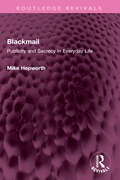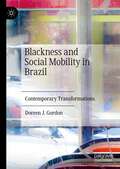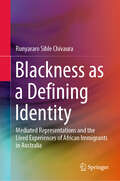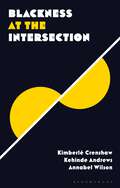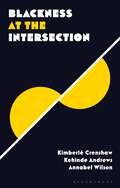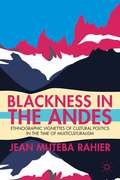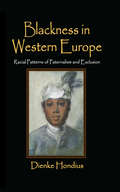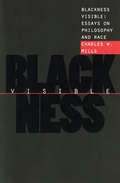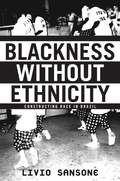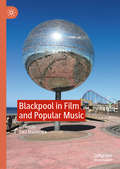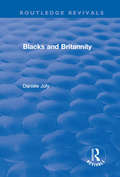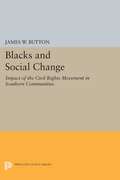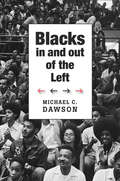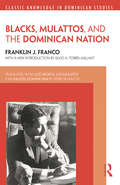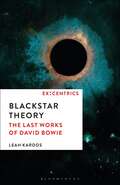- Table View
- List View
Blackmail: Publicity and Secrecy in Everyday Life (Routledge Revivals)
by Mike HepworthFirst Published in 1975 Blackmail: Publicity and Secrecy in Everyday Life examines why blackmail is often taken more seriously than murder and why it is widely considered as a serious social threat. Both fictional and real-life situations are used to explore the kinds of social situation in which various individuals become vulnerable to blackmail. In isolating the key ingredients of reputational blackmail in Britain over the last hundred years, this book is not preoccupied with threats to accuse someone of a major criminal offence such as murder or armed robbery, but rather with those cases where the penalties of discovery are less clear-cut and where public reaction may be much more ambivalent. Mike Hepworth focuses attention on the way blackmail is stigmatized in criminological and other literature and the possible validity of the stereotype in the light of alternative interpretations. This book is an interesting read for scholars and researchers of criminology and sociology.
Blackmail: Publicity and Secrecy in Everyday Life (Routledge Revivals)
by Mike HepworthFirst Published in 1975 Blackmail: Publicity and Secrecy in Everyday Life examines why blackmail is often taken more seriously than murder and why it is widely considered as a serious social threat. Both fictional and real-life situations are used to explore the kinds of social situation in which various individuals become vulnerable to blackmail. In isolating the key ingredients of reputational blackmail in Britain over the last hundred years, this book is not preoccupied with threats to accuse someone of a major criminal offence such as murder or armed robbery, but rather with those cases where the penalties of discovery are less clear-cut and where public reaction may be much more ambivalent. Mike Hepworth focuses attention on the way blackmail is stigmatized in criminological and other literature and the possible validity of the stereotype in the light of alternative interpretations. This book is an interesting read for scholars and researchers of criminology and sociology.
Blackness and Social Mobility in Brazil: Contemporary Transformations
by Doreen Joy GordonThis book examines the emergence of the black middle classes in urban Brazil, after 30 years of black mobilization and against the backdrop of deep economic, cultural, and political transformations taking place in recent decades within the country. One of the consequences of such transformations is said to be the restructuring of gender, race, and class relations. Utilizing qualitative research techniques such as ethnography, interviews, life histories, and focus groups among Afro-descendant families in the Northeast region of the country, the book explores contemporary race, class, and gender inequalities and their impact on daily lived experience. It reveals the dynamics underlying upward mobility, the diverse modes and experiences of social ascent into the middle classes, and the everyday negotiations involved in establishing one's status in the socio-racial hierarchy, which are not captured by other, more "macro" lenses. While some of these patterns are not peculiar to black people, this book argues that "race" shaped the contours and possibilities of social mobility in particular ways. This book is critical reading for specialists in the fields of inequality and race, class, and gender relations.
Blackness as a Defining Identity: Mediated Representations and the Lived Experiences of African Immigrants in Australia
by Runyararo Sihle ChivauraThis book explores the lived experiences of African immigrants in Australia, and the way they are represented in the media. By delving into the group’s everyday lives, the book exposes the roles that media and social perceptions play in the production and regulation of diasporic identities. Rather than being presented as objects of mediated representations, this book positions African immigrants in Australia as empowered subjects. The book employs inclusive research methods that make African immigrants active participants in the research, rather than passive objects. This is achieved through an expanded demographic study, a snapshot survey, and by taking a closer look at the lives of Africans in Australia through digital oral histories. This approach allows the group to have a say on how they feel they are positioned in society, on what space they are offered, and on how this affects their lives.
Blackness at the Intersection (Blackness in Britain)
by Kehinde Andrews Kimberlé Crenshaw Annabel WilsonA ground-breaking collection applying Crenshaw's concept of intersectionality to the black diasporic experience in Britain.In the 1980s, Professor Kimberlé Crenshaw first coined the term 'intersectionality'. Since then, the concept has spread across national and disciplinary boundaries, and has had a transformative impact on the way in which we understand identity and the experience of discrimination. But outside the US, the application of intersectional theory has largely been disconnected from any analysis of 'Blackness', despite intersectionality's origins in critical race theory (CRT). Curated by Crenshaw, Andrews and Wilson as well as several of the leading scholars of CRT, this collection bridges that gap, and is the first to apply both these concepts to contexts outside the US. Focusing on Blackness in Britain, the contributors examine how scholars and activists are employing intersectionality to foreground Black British experiences. Its essays encompass key issues such as gender and Black womanhood, issues of representation within contemporary British culture, and the position of Black Britons within institutions such as the family, education and health. The book also looks to the role intersectionality can play in shaping future political activism, and in forging links beyond 'Blackness' to other social movements.
Blackness at the Intersection (Blackness in Britain)
by Kimberlé Crenshaw, Kehinde Andrews and Annabel WilsonA ground-breaking collection applying Crenshaw's concept of intersectionality to the black diasporic experience in Britain.In the 1980s, Professor Kimberlé Crenshaw first coined the term 'intersectionality'. Since then, the concept has spread across national and disciplinary boundaries, and has had a transformative impact on the way in which we understand identity and the experience of discrimination. But outside the US, the application of intersectional theory has largely been disconnected from any analysis of 'Blackness', despite intersectionality's origins in critical race theory (CRT). Curated by Crenshaw, Andrews and Wilson as well as several of the leading scholars of CRT, this collection bridges that gap, and is the first to apply both these concepts to contexts outside the US. Focusing on Blackness in Britain, the contributors examine how scholars and activists are employing intersectionality to foreground Black British experiences. Its essays encompass key issues such as gender and Black womanhood, issues of representation within contemporary British culture, and the position of Black Britons within institutions such as the family, education and health. The book also looks to the role intersectionality can play in shaping future political activism, and in forging links beyond 'Blackness' to other social movements.
Blackness in the Andes: Ethnographic Vignettes of Cultural Politics in the Time of Multiculturalism
by J. RahierThis book examines, in Andean national contexts, the impacts of the 'Latin American multicultural turn' of the past two decades on Afro Andean cultural politics, emphasizing both transformations and continuities.
Blackness in Western Europe: Racial Patterns of Paternalism and Exclusion
by Dienke HondiusWhile the study of race relations in the United States continues to inspire and influence European thinking, Europeans have yet to confront their own history. To be black in Europe—whether during the sixteenth century or today—means sharing one crucial experience: being part of a small, but visible minority.European slave-owners, company directors, and investors in the distant past maintained an ocean-wide gap between themselves and the enslaved in the plantation colonies of the Caribbean. In the following centuries, this distance persisted. Even today, to be black in Europe often means to be one of a few black persons in a group. A racial pattern of exclusion has characterized European policy for more than four centuries.Dienke Hondius identifies ideas and attitudes toward "blackness," the concept of race as visible difference, developed in western Europe. She argues that racial discourses are generally dominated by paternalism—a concept usually used to explain power structures that is often applied to the nineteenth century. Hondius identifies five patterns of paternalism that influenced Europe much earlier and iniated trends of imagery and perception.Taking a chronological and thematic approach, Hondius first focuses on southern European societies in the Early Modern period and moves to northwest European societies in the Modern period. Addressing religion, law, and science, she concludes with a synthesis of developments from the twentieth century to the present.
Blackness in Western Europe: Racial Patterns of Paternalism and Exclusion
by Dienke HondiusWhile the study of race relations in the United States continues to inspire and influence European thinking, Europeans have yet to confront their own history. To be black in Europe—whether during the sixteenth century or today—means sharing one crucial experience: being part of a small, but visible minority.European slave-owners, company directors, and investors in the distant past maintained an ocean-wide gap between themselves and the enslaved in the plantation colonies of the Caribbean. In the following centuries, this distance persisted. Even today, to be black in Europe often means to be one of a few black persons in a group. A racial pattern of exclusion has characterized European policy for more than four centuries.Dienke Hondius identifies ideas and attitudes toward "blackness," the concept of race as visible difference, developed in western Europe. She argues that racial discourses are generally dominated by paternalism—a concept usually used to explain power structures that is often applied to the nineteenth century. Hondius identifies five patterns of paternalism that influenced Europe much earlier and iniated trends of imagery and perception.Taking a chronological and thematic approach, Hondius first focuses on southern European societies in the Early Modern period and moves to northwest European societies in the Modern period. Addressing religion, law, and science, she concludes with a synthesis of developments from the twentieth century to the present.
Blackness Visible: Essays on Philosophy and Race
by Charles W. MillsCharles Mills makes visible in the world of mainstream philosophy some of the crucial issues of the black experience. Ralph Ellison's metaphor of black invisibility has special relevance to philosophy, whose demographic and conceptual "whiteness" has long been a source of wonder and complaint to racial minorities. Mills points out the absence of any philosophical narrative theorizing and detailing race's centrality to the recent history of the West, such as feminists have articulated for gender domination.European expansionism in its various forms, Mills contends, generates a social ontology of race that warrants philosophical attention. Through expropriation, settlement, slavery, and colonialism, race comes into existence as simultaneously real and unreal: ontological without being biological, metaphysical without being physical, existential without being essential, shaping one's being without being in one's shape. His essays explore the contrasting sums of a white and black modernity, examine standpoint epistemology and the metaphysics of racial identity, look at black-Jewish relations and racial conspiracy theories, map the workings of a white-supremacist polity and the contours of a racist moral consciousness, and analyze the presuppositions of Frederick Douglass's famous July 4 prognosis for black political inclusion. Collectively they demonstrate what exciting new philosophical terrain can be opened up once the color line in western philosophy is made visible and addressed.
Blackness Without Ethnicity: Constructing Race in Brazil
by L. SansoneBlackness Without Ethnicity draws on fifteen years of his research in Bahia, Rio Suriname, and Amsterdam. Sansone uses his findings to explore the very different ways that race and ethnicity are constructed in Brazil and the rest of Latin America. He compares these Latin American conceptions of race to dominate notions of race that are defined by a black-white polarity and clearly identifiable ethnicities, formulations he sees as highly influenced by the US and to a lesser degree Western Europe. Sansone argues that understanding more complex and ambiguous notions of culture and identity will expand the international discourse on race and move it away from American dominated notions that are not adequate to describe racial difference in other countries (and also in the countries where the notions originated). He also explores the effects of globalization on constructions of race.
The Blackout in Britain and Germany, 1939–1945
by Marc WiggamThis book is the first major study of the blackout in the Second World War. Developing a comparative history of this system of civil defense in Britain and Germany, it begins by exploring how the blackout was planned for in both countries, and how the threat of aerial bombing framed its development. It then examines how well the blackout was adhered to, paying particular regard to the tension between its military value and the difficulties it caused civilians. The book then moves on to discuss how the blackout undermined the perception of security on the home front, especially for women. The final chapter examines the impact of the blackout on industry and transport. Arguing that the blackout formed an integral part in mobilising and legitimating British and German wartime discourses of community, fairness and morality, the book explores its profound impact on both countries.
The Blackout in Britain and Germany, 1939–1945 (PDF)
by Marc WiggamThis book is the first major study of the blackout in the Second World War. Developing a comparative history of this system of civil defense in Britain and Germany, it begins by exploring how the blackout was planned for in both countries, and how the threat of aerial bombing framed its development. It then examines how well the blackout was adhered to, paying particular regard to the tension between its military value and the difficulties it caused civilians. The book then moves on to discuss how the blackout undermined the perception of security on the home front, especially for women. The final chapter examines the impact of the blackout on industry and transport. Arguing that the blackout formed an integral part in mobilising and legitimating British and German wartime discourses of community, fairness and morality, the book explores its profound impact on both countries.
Blackpool in Film and Popular Music
by Ewa MazierskaThis collection examines Blackpool, Britain’s first and largest working-class seaside resort as a location for the production and consumption of British film and popular music, and the meaning of ‘Blackpool’ in films and songs. It examines representation of Blackpool in films such as Hindle Wakes, A Taste of Honey, Bhaji on the Beach, Away, Bob’s Weekend, The Harry Hill Movie and Miss Peregrine's Home for Peculiar Children, linking it to the concepts of heterotopia, purgatory, fantasy, simulacra and the carnivalesque. It also presents music in Blackpool through the history of its venues and examines development of punk and grime music in this seaside town. The authors argue that Blackpool in filmic and musical texts often stands for British culture, but increasingly for culture which is remembered or imagined rather than present and real.
Blacks and Britannity
by Danièle JolyThis title was first published in 2001: Featuring original research concerning young African-Caribbeans in Birmingham, this book addresses complex issues of urban violence and insecurity, racism and discrimination, alienation, resistance and social networks. Employing the methodology of sociological intervention developed by Alain Touraine, the book explores the experiences of a group of young people who are simultaneously presumed to be victims and perpetrators of violence. It examines their relationship to this violence, its meanings for and effects upon them, how they constitute themselves as social actors and subjects, and their capacity for action. The book also addresses the fact that ethnic monitoring and multicultural policies place the question of ethnicity on the British social and political agenda alongside issues of racism and discrimination. Exploring both the perceived and personally experienced position of young people within this context, it sheds important new light upon processes of group identification and action.
Blacks and Britannity
by Danièle JolyThis title was first published in 2001: Featuring original research concerning young African-Caribbeans in Birmingham, this book addresses complex issues of urban violence and insecurity, racism and discrimination, alienation, resistance and social networks. Employing the methodology of sociological intervention developed by Alain Touraine, the book explores the experiences of a group of young people who are simultaneously presumed to be victims and perpetrators of violence. It examines their relationship to this violence, its meanings for and effects upon them, how they constitute themselves as social actors and subjects, and their capacity for action. The book also addresses the fact that ethnic monitoring and multicultural policies place the question of ethnicity on the British social and political agenda alongside issues of racism and discrimination. Exploring both the perceived and personally experienced position of young people within this context, it sheds important new light upon processes of group identification and action.
Blacks and Jews in Literary Conversation (PDF)
by Emily Miller BudickBlacks and Jews in Literary Conversation explores the works of a range of black and Jewish writers, critics, and academics from the 1950s to the 1980s. By recording conversations both direct, such as essays and letters, and indirect, such as the fiction of Bernard Malamud, Philip Roth, Alice Walker, Cynthia Ozick, Toni Morrison, and James Baldwin, this book shows how dialogue can engender misperceptions and misunderstandings, and how blacks and Jews in America have both sought and resisted assimilation. By analyzing the history of this discourse, the author explores the ways in which ethnic fiction works in interethnic America, the effects of identity politics, and the tensions and bonds created as African and Jewish Americans continue to construct their ethnic and religious identities in the United States. 9780521631945 9780511585203
Blacks and Social Change: Impact of the Civil Rights Movement in Southern Communities (PDF)
by James W. ButtonThis book is a long-term empirical analysis of the impact of the civil rights movement on the real-life situations of southern blacks. Looking at the period from the late 1950s to the mid-1980s, it assesses the role of black political participation in six Florida cities.Originally published in 1989.The Princeton Legacy Library uses the latest print-on-demand technology to again make available previously out-of-print books from the distinguished backlist of Princeton University Press. These editions preserve the original texts of these important books while presenting them in durable paperback and hardcover editions. The goal of the Princeton Legacy Library is to vastly increase access to the rich scholarly heritage found in the thousands of books published by Princeton University Press since its founding in 1905.
Blacks In and Out of the Left (The W. E. B. Du Bois lectures #13)
by Michael C. DawsonThe radical black left has largely disappeared from the struggle for equality and justice. Michael Dawson examines the causes and consequences, and argues that the conventional left has failed to take race seriously as a force in reshaping American institutions and civil society. Black politics needs to find its way back to its radical roots.
Blacks In and Out of the Left (The W. E. B. Du Bois lectures #13)
by Michael C. DawsonThe radical black left has largely disappeared from the struggle for equality and justice. Michael Dawson examines the causes and consequences, and argues that the conventional left has failed to take race seriously as a force in reshaping American institutions and civil society. Black politics needs to find its way back to its radical roots.
Blacks, Latinos, and Asians in Urban America: Status and Prospects for Politics and Activism
by James JenningsThis volume of essays by scholars and activists focuses on the political and social relations between blacks, Latinos, and Asians in key urban centers. Collectively, the essays examine the particular status of relations between these groups, the reasons for conflict or consensus, and the prospects for future relations. While a number of cities are examined, the book focuses on Los Angeles, Washington, D.C., and Miami as particularly instructive case studies. Urban eruptions in these cities are examined in terms of the nature of political relations between blacks, Latinos, and Asians.These essays provide analyses within a sociohistorical context and offer the kind of political activism that might ensure consensus, rather than conflict, between these groups in urban America. As Luis Fuentes observes, This book should be read by all activists and scholars interested in changing the face of urban and ultimately, national America; for if communities of color can come together for progressive political action, then it will only be a matter of time before America finally begins to look like, and act like, what it has been preaching for generations.
Blacks, Mulattos, and the Dominican Nation (Classic Knowledge in Dominican Studies)
by Franklin J. FrancoBlacks, Mulattos, and the Dominican Nation is the first English translation of the classic text Los negros, los mulatos y la nación dominicana by esteemed Dominican scholar Franklin J. Franco. Published in 1969, this book was the first systematic work on the role of Afro-descendants in Dominican society, the first society of the modern Americas where a Black-Mulatto population majority developed during the 16th century. Franco’s work, a foundational text for Dominican ethnic studies, constituted a paradigm shift, breaking with the distortions of traditional histories that focused on the colonial elite to place Afro-descendants, slavery, and race relations at the center of Dominican history. This translation includes a new introduction by Silvio Torres-Saillant (Syracuse University) which contextualizes Franco's work, explaining the milieu in which he was writing, and bringing the historiography of race, slavery, and the Dominican Republic up to the present. Making this pioneering work accessible to an English-speaking audience for the first time, this is a must-have for anyone interested in the lasting effects of African slavery on the Dominican population and Caribbean societies.
Blacks, Mulattos, and the Dominican Nation (Classic Knowledge in Dominican Studies)
by Franklin J. FrancoBlacks, Mulattos, and the Dominican Nation is the first English translation of the classic text Los negros, los mulatos y la nación dominicana by esteemed Dominican scholar Franklin J. Franco. Published in 1969, this book was the first systematic work on the role of Afro-descendants in Dominican society, the first society of the modern Americas where a Black-Mulatto population majority developed during the 16th century. Franco’s work, a foundational text for Dominican ethnic studies, constituted a paradigm shift, breaking with the distortions of traditional histories that focused on the colonial elite to place Afro-descendants, slavery, and race relations at the center of Dominican history. This translation includes a new introduction by Silvio Torres-Saillant (Syracuse University) which contextualizes Franco's work, explaining the milieu in which he was writing, and bringing the historiography of race, slavery, and the Dominican Republic up to the present. Making this pioneering work accessible to an English-speaking audience for the first time, this is a must-have for anyone interested in the lasting effects of African slavery on the Dominican population and Caribbean societies.
Blackstar Theory: The Last Works of David Bowie (Ex:Centrics)
by Leah KardosBlackstar Theory takes a close look at David Bowie's ambitious last works: his surprise 'comeback' project The Next Day (2013), the off-Broadway musical Lazarus (2015) and the album that preceded the artist's death in 2016 by two days, Blackstar. The book explores the swirl of themes that orbit and entangle these projects from a starting point in musical analysis and features new interviews with key collaborators from the period: producer Tony Visconti, graphic designer Jonathan Barnbrook, musical director Henry Hey, saxophonist Donny McCaslin and assistant sound engineer Erin Tonkon.These works tackle the biggest of ideas: identity, creativity, chaos, transience and immortality. They enact a process of individuation for the Bowie meta-persona and invite us to consider what happens when a star dies. In our universe, dying stars do not disappear - they transform into new stellar objects, remnants and gravitational forces. The radical potential of the Blackstar is demonstrated in the rock star supernova that creates a singularity resulting in cultural iconicity. It is how a man approaching his own death can create art that illuminates the immortal potential of all matter in the known universe.
Blackstar Theory: The Last Works of David Bowie (Ex:Centrics #2)
by Leah KardosBlackstar Theory takes a close look at David Bowie's ambitious last works: his surprise 'comeback' project The Next Day (2013), the off-Broadway musical Lazarus (2015) and the album that preceded the artist's death in 2016 by two days, Blackstar. The book explores the swirl of themes that orbit and entangle these projects from a starting point in musical analysis and features new interviews with key collaborators from the period: producer Tony Visconti, graphic designer Jonathan Barnbrook, musical director Henry Hey, saxophonist Donny McCaslin and assistant sound engineer Erin Tonkon.These works tackle the biggest of ideas: identity, creativity, chaos, transience and immortality. They enact a process of individuation for the Bowie meta-persona and invite us to consider what happens when a star dies. In our universe, dying stars do not disappear - they transform into new stellar objects, remnants and gravitational forces. The radical potential of the Blackstar is demonstrated in the rock star supernova that creates a singularity resulting in cultural iconicity. It is how a man approaching his own death can create art that illuminates the immortal potential of all matter in the known universe.
